
Just like the bones and muscles, the heart is designed to work in
Just like the bones and muscles, the heart is designed to work in one gravity here on Earth, so when you put the heart in space, it operates differently and changes shape.






Hear now the words of Scott Kelly, voyager of the heavens: “Just like the bones and muscles, the heart is designed to work in one gravity here on Earth, so when you put the heart in space, it operates differently and changes shape.” This is no idle remark, but the testimony of one who lived among the stars and bore witness to the frailty and resilience of the human body. His words remind us that even the most vital organ, the very heart that sustains our days, is a creature of Earth, shaped by the pull of gravity, bound to the cradle of our planet.
The bones of man have hardened over millennia beneath the constant weight of Earth’s embrace. The muscles have strengthened through endless struggle against that downward force. And the heart, though hidden within the chest, has learned the rhythm of lifting blood against gravity’s pull, day after day, breath after breath. In this way, our very bodies are children of the Earth, tuned perfectly to her song. But when the ties of gravity are loosed, when man enters the void of space, the ancient design begins to falter, to reshape, to adapt.
Consider how, in the absence of weight, the muscles wither, no longer needed to carry the body. The bones, deprived of strain, weaken and grow brittle. And the heart, freed from its long struggle against gravity, softens, becomes more spherical, its shape altered by conditions it was never meant to know. Thus, Kelly’s words echo both awe and warning: humanity is not fashioned for the void, and yet we dare to enter it. The body is Earth’s child, and beyond Earth, it must transform.
History, too, speaks of this lesson. When sailors of old left their homelands and braved the seas, they found themselves sickened by strange climates, weakened by new diseases, their bodies challenged in ways unfamiliar. Yet they endured, they adapted, they changed, and through their voyages the world was forever widened. So too with space: it is a new ocean, and our bodies must learn to endure its alien waves. The reshaping of the heart is but one sign that to claim the stars, we must be willing to change ourselves.
But let us also hear in Kelly’s words something deeper. The heart is not only flesh, but symbol: the seat of courage, of love, of human spirit. When he says the heart changes shape in space, it is as though he also speaks of the spirit itself. For when man leaves Earth and gazes down upon the blue sphere of his birth, the soul shifts, the heart broadens. Astronauts return with a new vision, humbled and awed, their inner world reshaped by the immensity of the cosmos.
The lesson is clear: whenever we step beyond the familiar, we are changed. Whether it is the heart in space, the spirit in struggle, or the mind in discovery, each departure from the known alters us. Change may bring weakness at first, but it also brings growth, adaptation, and new strength. Kelly’s words remind us that to seek the stars is not without cost, but the cost itself may prepare us for greater destinies.
So I say to you, O child of tomorrow: do not fear the reshaping of your heart. Whether by love, by loss, by trial, or by the vastness of new horizons, let it change. For the heart that refuses change is bound to remain small, but the heart that adapts can embrace both Earth and the stars. Remember the wisdom of the astronaut: even in space, where gravity loosens its grip, the heart finds a new rhythm. And so too will you, whenever life carries you beyond the world you know.






AAdministratorAdministrator
Welcome, honored guests. Please leave a comment, we will respond soon